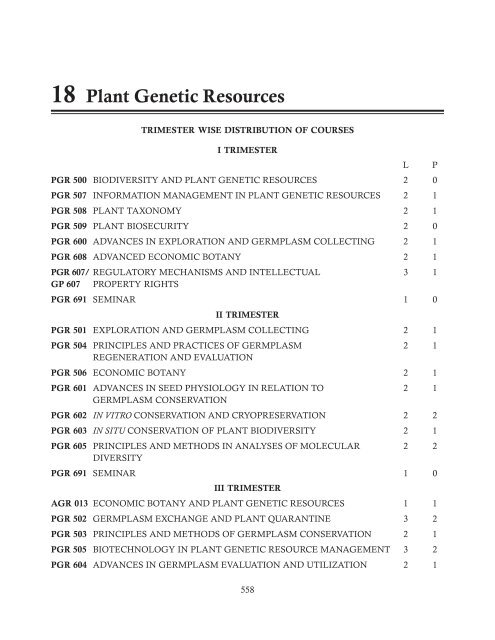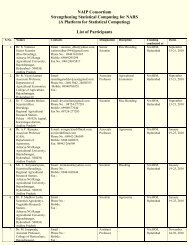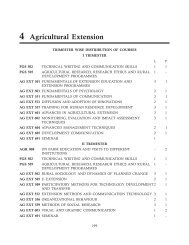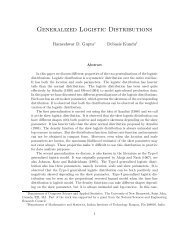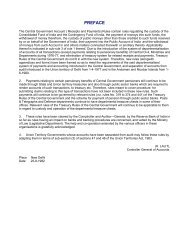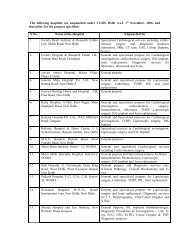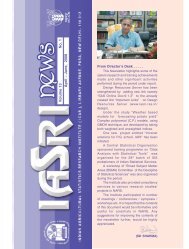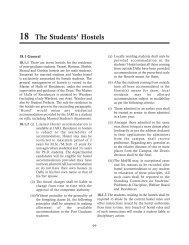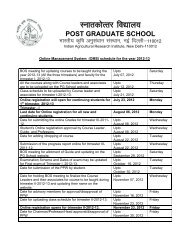18 Plant Genetic Resources - PG School, IARI Management System
18 Plant Genetic Resources - PG School, IARI Management System
18 Plant Genetic Resources - PG School, IARI Management System
You also want an ePaper? Increase the reach of your titles
YUMPU automatically turns print PDFs into web optimized ePapers that Google loves.
<strong>18</strong> <strong>Plant</strong> <strong>Genetic</strong> <strong>Resources</strong><br />
TRIMESTER WISE DISTRIBUTION OF COURSES<br />
I TRIMESTER<br />
<strong>PG</strong>R 500 BIODIVERSITY AND PLANT GENETIC RESOURCES 2 0<br />
<strong>PG</strong>R 507 INFORMATION MANAGEMENT IN PLANT GENETIC RESOURCES 2 1<br />
<strong>PG</strong>R 508 PLANT TAXONOMY 2 1<br />
<strong>PG</strong>R 509 PLANT BIOSECURITY 2 0<br />
<strong>PG</strong>R 600 ADVANCES IN EXPLORATION AND GERMPLASM COLLECTING 2 1<br />
<strong>PG</strong>R 608 ADVANCED ECONOMIC BOTANY 2 1<br />
<strong>PG</strong>R 607/ REGULATORY MECHANISMS AND INTELLECTUAL 3 1<br />
GP 607 PROPERTY RIGHTS<br />
<strong>PG</strong>R 691 SEMINAR 1 0<br />
II TRIMESTER<br />
<strong>PG</strong>R 501 EXPLORATION AND GERMPLASM COLLECTING 2 1<br />
<strong>PG</strong>R 504 PRINCIPLES AND PRACTICES OF GERMPLASM 2 1<br />
REGENERATION AND EVALUATION<br />
<strong>PG</strong>R 506 ECONOMIC BOTANY 2 1<br />
<strong>PG</strong>R 601 ADVANCES IN SEED PHYSIOLOGY IN RELATION TO 2 1<br />
GERMPLASM CONSERVATION<br />
<strong>PG</strong>R 602 IN VITRO CONSERVATION AND CRYOPRESERVATION 2 2<br />
<strong>PG</strong>R 603 IN SITU CONSERVATION OF PLANT BIODIVERSITY 2 1<br />
<strong>PG</strong>R 605 PRINCIPLES AND METHODS IN ANALYSES OF MOLECULAR 2 2<br />
DIVERSITY<br />
<strong>PG</strong>R 691 SEMINAR 1 0<br />
III TRIMESTER<br />
AGR 013 ECONOMIC BOTANY AND PLANT GENETIC RESOURCES 1 1<br />
<strong>PG</strong>R 502 GERMPLASM EXCHANGE AND PLANT QUARANTINE 3 2<br />
<strong>PG</strong>R 503 PRINCIPLES AND METHODS OF GERMPLASM CONSERVATION 2 1<br />
<strong>PG</strong>R 505 BIOTECHNOLOGY IN PLANT GENETIC RESOURCE MANAGEMENT 3 2<br />
<strong>PG</strong>R 604 ADVANCES IN GERMPLASM EVALUATION AND UTILIZATION 2 1<br />
558<br />
L<br />
P
<strong>PG</strong>R 606 ECOLOGY AND BIODIVERSITY 2 1<br />
<strong>PG</strong>R 609 ADVANCED PLANT TAXONOMY 2 1<br />
<strong>PG</strong>R 691 SEMINAR 1 0<br />
Core Courses:<br />
M.Sc.: <strong>PG</strong>R 500, <strong>PG</strong>R 501, <strong>PG</strong>R 502, <strong>PG</strong>R 503, <strong>PG</strong>R 504, <strong>PG</strong>R 505, <strong>PG</strong>R 506, <strong>PG</strong>R 508, <strong>PG</strong>R 509<br />
GP 500, GP 520, AS 501, <strong>PG</strong>S 503<br />
559
PLANT GENETIC RESOURCES<br />
Major Field : <strong>Plant</strong> <strong>Genetic</strong> <strong>Resources</strong><br />
Minor Fields : Ph.D. student shall take two minors (9 credits of course work in each) from any of the<br />
other fields outside his/her own.<br />
M.Sc. student shall take one minor (9 credits of course work) from any of the other<br />
fields outside his/her own.<br />
DESCRIPTION OF COURSES<br />
AGR 013 ECONOMIC BOTANY AND PLANT GENETIC RESOURCES<br />
(1L+1P) III<br />
Objective<br />
This course is aimed at understanding the economic uses on plant species and potential of plant<br />
species as a natural resource or raw material for use in crop improvement.<br />
Theory<br />
UNIT I<br />
Origin and history of agriculture; dynamics of domestication; centres of plant origin and diversity.<br />
UNIT II<br />
Patterns of variation; classification of cultivated plants; concept of gene pool; geographical<br />
distribution of crops of Indian origin.<br />
UNIT III<br />
Principles of <strong>PG</strong>R exploration and collection; introduction, acclimatization and utilization;<br />
principles of plant quarantine; principles and strategies for germplasm conservation; ex situ and in<br />
situ methods.<br />
UNIT IV<br />
Components of genebank: seed genebank, field genebank, in vitro repository, cryo genebank; DNA<br />
libraries, herbarium.<br />
UNIT V<br />
Policy issues: assessing economic values, conflict over ownership, management and use; data<br />
documentation.<br />
Practicals<br />
Preparation of herbarium; recording the data for characterization and evaluation of genetic resources<br />
in the field; Processing of samples of genetic resources for long-term conservation: testing the<br />
viability and seedling vigour, testing of moisture content, equilibration of moisture content,<br />
packaging of sample for long-term conservation in Seed Genebank; in vitro conservation of genetic<br />
resources: preparation of culture medium, sterlization and inoculation of explants, maintenance<br />
of cultures in the In vitro Genebank; data documentation, demonstration of database on plant<br />
genetic resources.<br />
560
Suggested Readings<br />
Dhillon, B.S., Tyagi, R.K., Lal, A. and Saxena, S. (eds.). 2004. <strong>Plant</strong> <strong>Genetic</strong> Resource <strong>Management</strong>.<br />
Narosa Publishing House, New Delhi.<br />
Frankel, O.H., Brown, A.D. and Burdon, J.J. 1995. The Conservation of plant Biodiversity. Camb.<br />
Univ. Press.<br />
Harlan, J.R. 1992. Crops and Man (American Society of Agronomy, Crop science Society of<br />
America).<br />
Hawks, J.G. 1983. The Diversity of Crop <strong>Plant</strong>s Harvard Univ. Press, Cambridge, Mass London.<br />
Paroda, R.S., Arora, R.K. and Chandel, K.P.S. 1987. <strong>Plant</strong> genetic resources: Indian perspective.<br />
NB<strong>PG</strong>R, New Delhi.<br />
Rana, R.S., Saxena, R.K., Tyagi, R.K., Saxena, S. and Mitter, V. 1994. Ex-situ Conservation of<br />
<strong>PG</strong>R. NB<strong>PG</strong>R, New Delhi.<br />
<strong>PG</strong>R 500 BIODIVERSITY AND PLANT GENETIC RESOURCES<br />
(2L+0P) I<br />
Objective<br />
To provide an overview of global biodiversity, agrobiodiversity and agricultural intensification,<br />
and an understanding of basic science and management issues related to plant genetic resources<br />
including policy.<br />
Theory<br />
UNIT I<br />
Biodiversity-an overview; genetic, species and ecosystem diversity; determinants of biodiversity.<br />
UNIT II<br />
Higher plant diversity, species richness and endemism.<br />
UNIT III<br />
Biodiversity and agricultural intensification: agriculture as friend and foe of biodiversity,<br />
harmonizing biodiversity conservation and agricultural development, policy considerations along<br />
the interface between biodiversity and agriculture.<br />
UNIT IV<br />
Agro-biodiversity and plant genetic resources; origin and history of agriculture; dynamics of<br />
domestication; centers of crop plant origin and diversity; geographical distribution of crops of<br />
Indian origin.<br />
UNIT V<br />
An overview of plant genetic resources management (importance and usefulness of germplasm,<br />
germplasm conservation, threat of genetic vulnerability, global concerns etc.).<br />
UNIT VI<br />
Managing plant genetic resources: Basic science issues (genetic vulnerability and crop diversity,<br />
crop diversity-institutional responses, in situ conservation of genetic resources, the science of<br />
collecting genetic resources, the science of managing genetic resources, using genetic resources,<br />
biotechnology and germplasm conservation etc.).<br />
561
UNIT VII<br />
Managing plant genetic resources: policy issues (exchange of genetic resources: quarantine, IPR;<br />
genetic resources: assessing economic value; conflicts over ownership, management and use; national<br />
and international treaties/legislations: CBD, IT-<strong>PG</strong>RFA, GPA, PVP&FR Act, Biodiversity Act<br />
etc.).<br />
Suggested Readings<br />
Brown, A.H.D., Clegg, M.T., Kahler, A.L. and Weir, B.S. (eds.)1990. <strong>Plant</strong> population genetics, breeding,<br />
and genetic resources , Sinauer Associates, USA.<br />
Brown, A.H.D., Frankel, O.H., Marshall, D.R. and Williams, J.T. 1989. The use of plant gentic<br />
resources , Cambridge Univ. Press<br />
Chapman & Hall 1992. Global biodiversity: Status of the Earth’s living resources, World<br />
Conservation Monitoring Centre, London. xx + 594 pp.<br />
Frankel, O.H. and Michaele, E.S. 1987. Conservation and evolution, Cambridge Univ. Press.<br />
Harlan, J.R. 1992. Crops & Man (Second Edition) , American Society of Agronomy Inc., Crop<br />
Science Society of America Inc., Madison, Wisconsin, USA.<br />
Holden, J.H.N. and Williams, J.T. 1984. Crop genetic resources: conservation and evaluation, IB<strong>PG</strong>R.<br />
Plucknett, D.L., Smith, N.J.H. and Williams, J.T. 1987. Genebanks & the world’s food, Princeton<br />
Univ. Press.<br />
Primack, R.B. 1993. Essentials of conservation biology , Sinauer Associates Inc., USA.<br />
<strong>PG</strong>R 501 EXPLORATION AND GERMPLASM COLLECTING<br />
(2L+1P) II<br />
Objective<br />
To provide information about science of germplasm collecting.<br />
Theory<br />
UNIT I<br />
History and importance of germplasm exploration; distribution and extent of prevalent genetic<br />
diversity; phyto-geographical regions/ecological zones and associated diversity; mapping ecogeographic<br />
distribution of diversity, threatened habitats, use of flora.<br />
UNIT II<br />
Concept of population and gene pool, variations in population and their classification, gene<br />
frequencies in populations, rare and common alleles, gene pool sampling in self- and cross-pollinated<br />
and vegetatively propagated species, non-selective, random and selective sampling strategies.<br />
UNIT III<br />
Strategies and logistics of plant exploration and collection, coarse and fine grid surveys, practical<br />
problems in plant exploration, use of in vitro methods in germplasm collection.<br />
UNIT IV<br />
Ethnobotanical aspects of <strong>PG</strong>R, crop botany, farming systems, collecting wild relatives of crop<br />
plants.<br />
UNIT V<br />
Post-exploration handling of germplasm collections, collection and preservation of specimens,<br />
importance and use of herbaria and preparation of herbarium specimens.<br />
562
UNIT VI<br />
Present status and future strategies in collecting of major crops of Indian origin such as rice, maize,<br />
sorghum, sesame, brassica, okra, eggplant, cotton, mango, etc.<br />
Practicals<br />
<strong>Plant</strong> exploration and germplasm collecting; documenting passport data; use of flora and maps;<br />
collecting vegetatively propagated species; local field visit for recording of ethnobotanical<br />
information/notes; post exploration handling of germplasm accessions; collecting wild relatives<br />
of crop plants; preparation, maintenance and use of herbarium; local field visit for herbarium<br />
collection; report writing on germplasm collecting missions.<br />
Suggested Readings<br />
Falk, D.A. and Holsinger, K.E. 1991. <strong>Genetic</strong>s and conservation of rare plants, Oxford University<br />
Press, New York, USA.<br />
Frankel, O.H. and Bennett, E. 1970. <strong>Genetic</strong> <strong>Resources</strong> in <strong>Plant</strong>s - Their Exploration and Conservation,<br />
Oxford: Blackwell Scientific.<br />
Frankel, O.H. and Hawks, J.G. 1975. Crop genetic resources for today and tomorrow, Cambridge Univ.<br />
Press.<br />
Guriano, L., Ramanatha Rao, V. and Reid, R. 1995. Collecting plant genetic diversity- Technical<br />
Guidelines, CAB International, Wallingford, U.K.<br />
Other relevant books/ serials and I<strong>PG</strong>RI publication etc. and original papers<br />
<strong>PG</strong>R 502 GERMPLASM EXCHANGE AND PLANT QUARANTINE<br />
(3L+2P) III<br />
Objective<br />
To provide information about germplasm exchange and plant quarantine including exchange of<br />
genetically modified plants.<br />
Theory<br />
UNIT I<br />
History, principles, objectives and importance of plant introduction; Prerequisites, conventions,<br />
national and international legislations and policies on germplasm collection and exchange.<br />
UNIT II<br />
<strong>Plant</strong> quarantine- introduction, history, principles, objectives and relevance; Regulations and plant<br />
quarantine set up in India; Pest risk analysis, pest and pathogen information database; Quarantine<br />
in relation to integrated pest management; Economic significance of seed-borne pests (insects,<br />
mites, non-insect pests, nematodes, fungi, bacteria, viruses, phytoplasma etc.).<br />
UNIT III<br />
Detection and identification of pests including use of recent techniques like ELISA, PCR etc.,<br />
Symptoms of pest damage, salvaging techniques for infested/infected germplasm, post-entry<br />
quarantine operation, seed treatment and other prophylactic treatments and facilities.<br />
UNIT IV<br />
Domestic quarantine; seed certification; International linkages in plant quarantine; weaknesses<br />
and future thrust.<br />
563
UNIT V<br />
<strong>Genetic</strong>ally modified organisms (GMOs) or genetically engineered plants (GEPs), Concepts of<br />
biosafety, risk analysis and consequences of spread of GE crops on the environment; Treaties and<br />
multilateral agreements governing trans-boundary movement of GEPs or GMOs, Indian regulatory<br />
system for biosafety.<br />
Practicals<br />
Inventory of IQ/ EQ samples; joint inspection for pest detection; history, principles, objectives<br />
and relevance of <strong>Plant</strong> Quarantine; seed –borne pests of quarantine significance; quarantine in<br />
relation to integrated pest management; salvaging of infested germplasm; seed treatment and other<br />
prophylactic treatments and facilities; domestic quarantine; seed-health certification.<br />
Suggested Readings<br />
Anonymous. 1985. <strong>Plant</strong> Quarantine Treatment Manual, USDA.<br />
Dent, David 1991. Insect Pest <strong>Management</strong>. C.A.B. International Publication 604 p.<br />
Khetarpal, R.K., Varaprasad, K.S., Lal, A., Agarwal, P.C. and Lal, B. 2001. <strong>Plant</strong> Quarantine of<br />
Germplasm under Exchange. pp. 99-115. In : National Bureau of <strong>Plant</strong> <strong>Genetic</strong> <strong>Resources</strong>: A<br />
Compendium of Achievements- Dhillon BS, Varaprasad KS, Srinivasan K, Singh M, Archak<br />
S, Srivastava U and Sharma GD (Eds.). NB<strong>PG</strong>R Publication, New Delhi 329 p.<br />
Neergard, P. 1979. Seed Pathology, Vol. I&II, Macmillan Press Ltd., London, U.K. 1191 p.<br />
Richards, O.W. and Davies, R.G. 1973. A general textbook of Entomology. Butler and Tanner Ltd.<br />
Frome and London. 886 p.<br />
Richardson, M.J. 1990. An Annotated list of seed-borne diseases (Fourth Edition). International Seed<br />
Testing Association, P.O. Box 412. CH 8046 Zurich, Switzerland.<br />
William, B. Hewitt and Luigi, Chiarappa 1977. <strong>Plant</strong> Health and Quarantine in International Transfer<br />
of <strong>Genetic</strong> <strong>Resources</strong>. CRC Press, Inc., Ohio Publication 345p.<br />
<strong>PG</strong>R 503 PRINCIPLES AND METHODS OF GERMPLASM CONSERVATION<br />
(2L+1P) III<br />
Objective<br />
To impart knowledge on crop germplasm conservation with particular emphasis on seed genebanks.<br />
Theory<br />
UNIT I<br />
In situ and ex situ conservation: concept of biosphere reserves, gene sanctuaries, on-farm<br />
conservation, field genebanks, botanical gardens, herbal gardens, in vitro repositories and cryobanks.<br />
UNIT II<br />
Short-, medium- and long-term conservation, concept of base, active and working collections,<br />
seed structure and function, physiological and genetic changes during storage, theories of aging,<br />
viability equations, predicting storage life of seeds, dormancy and germination.<br />
UNIT III<br />
Genebank management: acquisition, accessioning and processing of germplasm samples for storage,<br />
genebank standards for various crops, ISTA, AOSA, I<strong>PG</strong>RI guidelines, monitoring and regeneration<br />
of plant germplasm.<br />
564
UNIT IV<br />
Design of storage facilities, maintenance and operation of storage modules.<br />
UNIT IV<br />
Information management in genebanks, strategies for revival and rescue of rare genetic material.<br />
Practicals<br />
Seed structure and morphology; seed germination and seedling evaluation; seed viability test, seed<br />
sampling and purity analysis, seed dormancy and dormancy breaking treatments, moisture testing<br />
methods, vigour testing methods and seed leachate analysis, accelerated aging of seeds and their<br />
assessment, seed processing and storage in Gene Bank.<br />
Suggested Readings<br />
Bewley, J.D. and Black, M. 1994. Seeds Physiology of Development and Germination. Second Edition.<br />
Pleenum Press, New York and London.<br />
Bonner, F.T. 1990. Storage of seeds. Potential and limitation of germplasm conservation. Forest<br />
Ecol. and Manage.<br />
Ellis, R.H., Hong, T.D. and Roberts, E.H. 1985a. Handbook of Seed Technology for Genebank. Volume<br />
II. Principles and Methodology. International Board for <strong>Plant</strong> <strong>Genetic</strong> <strong>Resources</strong>, Rome.<br />
Ellis, R.H., Hong, T.D. and Roberts, E.H. 1985b. Handbook of Seed Technology for Genebank.<br />
Compendium of Specific Germination Information and Test Recommendations. International<br />
Board for <strong>Plant</strong> <strong>Genetic</strong> <strong>Resources</strong>, Rome.<br />
Hong, T.D. and Ellis, R.H. 1996. A protocol to determine seed storage behaviour. International <strong>Plant</strong><br />
<strong>Genetic</strong> <strong>Resources</strong> Institute I<strong>PG</strong>RI Technical Bulletin No. 1, Rome.<br />
Roberts, E.H. 1972. Viability of Seeds, Chapman and Hall, London.<br />
Thomoson, J.R. 1979. An Introduction to seed Technology.<br />
<strong>PG</strong>R 504<br />
PRINCIPLES AND PRACTICES OF GERMPLASM REGENERATION AND<br />
EVALUATION<br />
(2L+1P) II<br />
Objective<br />
To educate students about science of managing genetic resources including principles involved in<br />
maintaining genetic integrity during regeneration, germplasm characterization and evaluation.<br />
Theory<br />
UNIT I<br />
Grmplasm management systems: global scenario; genetic variation in crop plants and management<br />
of germplasm collections.<br />
UNIT II<br />
Principles and practices of germplasm regeneration and maintenance, breeding systems and mode<br />
of reproduction; maintaining sufficiently large populations for effective conservation of farmer<br />
landraces.<br />
UNIT III<br />
Germplasm characterization/evaluation procedures; evaluation of germplasm for specific traits;<br />
key issues for the improvement of characterization, evaluation and use of plant genetic resources;<br />
concept of core collection.<br />
565
UNIT IV<br />
Measuring diversity using agromorphological data; gene markers and their use in <strong>PG</strong>R management.<br />
UNIT V<br />
Evaluation and maintenance of wild relatives of crop plants; genetic enhancement/pre-breeding<br />
and use of alien/unadapted genetic resources in crop improvement.<br />
Practicals<br />
Field layout and experimental designs, recording field data on germplasm evaluation in different<br />
agri-horticultural crops, biochemical and phyto-chemical evaluation of crop germplasm, data<br />
processing, documentation, analysis of diversity and cataloguing.<br />
Suggested Readings<br />
Brown, A.H.D., Clegg, M.T., Kahler, A.L., Weir, B.S. (eds.) 1990. <strong>Plant</strong> population genetics, breeding,<br />
and genetic resources, Sinauer Associates, USA.<br />
Brown, A.H.D., Frankel, O.H., Marshall, D.R. and Williams, J.T. 1989. The use of plant gentic<br />
resources, Cambridge Univ. Press.<br />
Frankel, R. and Galun, E. 1977. Pollination mechanisms, reproduction and plant breeding.<br />
Hayward, M.D., Bosemak, N.O. and Romagosa, I. 1993. <strong>Plant</strong> Breeding: Principles & Practices ,<br />
Chapman & Hall.<br />
Holden, J.H.N. and Williams, J.T. 1984. Crop genetic resources: conservation and evaluation, IB<strong>PG</strong>R.<br />
Paroda, R.S. and Arora, R.K. (eds.) 1991. <strong>Plant</strong> genetic resources: conservation and management,<br />
NB<strong>PG</strong>R.<br />
Regeneration of accessions in seed collections: a decision guide 1997. by I<strong>PG</strong>RI: Handbook for genebanks<br />
No. 5.<br />
Stoskopf, N.C. 1993. <strong>Plant</strong> Breeding: Theory & Practice, Westview Press.<br />
<strong>PG</strong>R 505 BIOTECHNOLOGY IN PLANT GENETIC RESOURCE MANAGEMENT (3L+2P) III<br />
Objective<br />
To provide information on use of biotechnology in germplasm conservation including molecular<br />
characterization and conservation technologies.<br />
Theory<br />
UNIT I<br />
Tissue culture and <strong>PG</strong>R conservation, Tissue culture media, Sterilization techniques, In vitro clonal<br />
multiplication, Somatic embryogenesis, Meristem culture and virus elimination, In vitro conservation<br />
–Introduction and principle, Strategies for in vitro short- and medium-term conservation, In vitro<br />
collection, in vitro exchange of germplasm.<br />
UNIT II<br />
<strong>Plant</strong> Cryopreservation-Introduction, Principle of cryotolerance, Techniques of cryopreservation:<br />
slow cooling, desiccation, pregrowth, encapsulation-dehydration, vitrification, droplet freezing,<br />
Cryoprotectants, Cryopreservation of seeds and pollen, Cryopreservation of in vitro cultures,<br />
Application of in vitro cryopreservation techniques in monocots and dicots - case studies,<br />
566
<strong>Management</strong> of in vitro and cryobanks, <strong>Genetic</strong> stability of in vitro conserved and cryopreserved<br />
germplasm, Importance of database for in vitro and cryopreserved germplasm.<br />
UNIT III<br />
The need for plant germplasm characterization; introduction to different techniques for plant<br />
germplasm characterization; biochemical and molecular marker techniques for germplasm<br />
characterization and evaluation; recent advances in molecular genetic diversity analysis –use of<br />
SNPs and microarrays; data handling and statistical analysis; analysis of genetic diversity; marker<br />
assisted evaluation of core collections; conservation of genomic resources; molecular markers for<br />
gene bank management; detection of adventitious transgenics.<br />
Practicals<br />
• Preparation of stock solutions; media preparation; preparation of explants and culture initiation<br />
in monocots and dicots; meristem isolation and culture establishment; subculture of shoots in<br />
monocots and dicots, hardening and field establishment of plantlets; preparation of<br />
cryoprotectant solutions and regrowth media; cryopreservation of in vitro cultures- isolation of<br />
explants and pretreatment.<br />
• Encapsulation-dehydration technique; encapsulation-vitrificaion technique; assessing genetic<br />
stability of in vitro conserved and cryopreserved germplasm.<br />
• Basic techniques in molecular biology; isolation of Genomic DNA from leaves; purification of<br />
DNA Quantification of DNA; PCR; RAPD, ISSR, demonstration of RFLP, AFLP, STMS;<br />
data Handling and Statistical Analysis.<br />
Suggested readings<br />
Ashmore, S.E. 1997. Status Report on the Development and Application of In Vitro Techniques for the<br />
Conservation and Use of <strong>Plant</strong> <strong>Genetic</strong> <strong>Resources</strong>. I<strong>PG</strong>RI, Rome.<br />
Benson, E.E. (ed.) 1999. <strong>Plant</strong> Conservation Biotechnology. Taylor & Fancis Ltd. London.<br />
Bhojwani, S.S. and Razdan, M.K. 1983. <strong>Plant</strong> Tissue Culture: Theory and Practice. Elsevier Science<br />
Publishing Co.Inc. New York.<br />
Dodds, J.H. (eds.) 1991. In Vitro Methods for Conservation of <strong>Plant</strong> <strong>Genetic</strong> <strong>Resources</strong>. Chapman and<br />
Hall, London.<br />
Dodds, J.H. and Robberts, L.W. 1985. Experiments in <strong>Plant</strong> Tissue Culture, 2nd Ed., Cambridge<br />
University Press, Cambridge, London.<br />
Engelmann, F. and Takagi, H. (eds) 2000. Cryopreservation of Tropical <strong>Plant</strong> Germplasm - Current<br />
Research Progress and Application, I<strong>PG</strong>RI, Rome/JIRCAS/Japan.<br />
Ford-Lloyd, B.V., Newburry, J.H. and Callow, J.A. (eds.) 1998. Biotechnology and <strong>Plant</strong> <strong>Genetic</strong><br />
<strong>Resources</strong>: Conservation and Use. CABI, Wellingford.<br />
Griffin, H.G. and Griffin, A.M. 1994. PCR Technology: Current Innovations. CRC Press, London.<br />
Henry, R.J. (Editor) <strong>Plant</strong> Genotyping: The DNA Fingerprinting of <strong>Plant</strong>s, Publisher: CABI Publishing.<br />
Karp, A., Isaac, P.G. and Ingram, D.S. 1998. Molecular Tools for Screening Biodiversity – <strong>Plant</strong>s and<br />
Animals. Chapman and Hall, London.<br />
Kartha, K.K. (ed) 1995. Cryopreservation of <strong>Plant</strong> Cells and Organs. CRC Press, Boca Rataon, Florida.<br />
Sambrook, J., MacCallum, P., Russell, D.(eds.) 2001. Molecular Cloning: A Laboratory Manual (Third<br />
Edition),CSHL Press.<br />
567
<strong>PG</strong>R 506 ECONOMIC BOTANY<br />
(2L+1P) II<br />
Objective<br />
Theory<br />
Practicals<br />
To study the relationship between people and plants including anthropology, botany and<br />
environmental conservation.<br />
UNIT I<br />
Origin and history of agriculture, domestication and adaptations of cultivated plants.<br />
UNIT II<br />
Taxonomy, reproductive systems and breeding behaviour of crop plants.<br />
UNIT III<br />
Origin, evolution, botany, cultivation, use, genetic resource activities and utilization of genetic<br />
diversity of important crops, viz., cereals, millets, legumes, forage and fodder crops, medicinal and<br />
aromatic plants, beverages, oil yielding plants, spices and condiments, wood and timber yielding<br />
taxa, fumitory and masticatory plants, vegetable crops, sugar, starch and cellulose yielding plants,<br />
rubber yielding plants, insecticidal and herbicidal plants, fruits and nuts, flowering agents, gums<br />
and resins, fiber yielding plants, under-utilized and under-exploited plants, new crops, pseudocereals,<br />
important taxa in agro-forestry, horticulture and floriculture, processing and use of crop<br />
residues.<br />
Botanical microtechniques for the study of structure, development and biochemical status of plant<br />
parts; structure of economic important plant parts; case studies on adaptations during domestication-<br />
Solanum species; histochemical localization of chemical constituents in economically important<br />
plant parts; identification and status of economically important plant parts in different groups of<br />
plants.<br />
Suggested readings<br />
An Introduction to Modern Economic Botany. By Maiti RK and Singh VP, 2006 Eastern Book<br />
Corporation, Delhi<br />
Economic Botany: <strong>Plant</strong>s in Our World. By Beryl Brintnall Simpson, Molly Ogorzaly, Simpson<br />
Beryl. 2001. Mcgraw-hill Science/engineering/math.<br />
Economic Botany in the Tropics. By Kochhar (Third edition), Macmillan Publishers, India<br />
A text book of Economic Botany. By Beryl B. Simpson, 1991, Univ. of Texas.<br />
The Economic Botany of the Himalayas. Atkinson, E.T., 1980.<br />
<strong>Plant</strong>s for Human Consumption. G. Kunkel. Koeltz Scientific Books, West Germany. 1984, 393 pp.<br />
<strong>Plant</strong> that feed and serve us. By Hvass, Else, Blandford Press, London, 1973.<br />
<strong>Plant</strong> genetic resources: conservation and management (1991) By R.S. Paroda & R.K. Arora (eds.),<br />
NB<strong>PG</strong>R .<br />
Economic Botany: A Textbook of Useful <strong>Plant</strong>s and <strong>Plant</strong> Products. By Albert F. Hill, 1952, Second<br />
Edition, New York Toronto London McGraw-hill Book Company, Inc.<br />
568
<strong>PG</strong>R 507 INFORMATION MANAGEMENT IN PLANT GENETIC RESOURCES<br />
(2L+1P) I<br />
Objective<br />
Theory<br />
To train the students in germplasm data base management using modern tools and softwares.<br />
UNIT I<br />
Statistical techniques in management of germplasm, developing core collection, estimation of<br />
sample size during plant explorations, impact of sampling on population structure.<br />
UNIT II<br />
Sequential sampling for viability estimation, introduction of binomial, normal and negative<br />
cumulative normal, use of Probit scales, viability equations and nomograms, estimation of sample<br />
size for storage and viability testing.<br />
UNIT III<br />
Germplasm documentation; basics of computer and operating systems, database management<br />
system, use of statistical softwares, pictorial and graphical representation of data; Introduction to<br />
communication network.<br />
Practicals<br />
Experimental designs and data analysis; viability equations, sampling strategies, data documentation,<br />
cataloguing.<br />
Suggested Readings<br />
Painting, K.A., Perry, M.C., Denning, R.A. and Ayad, W.G. 1993. Guide Book for <strong>Genetic</strong> <strong>Resources</strong><br />
Documentation. I<strong>PG</strong>RI, Rome, Italy.<br />
Puzone, L. and Th. Hazekamp 1996. Characterization and Documentation of <strong>Genetic</strong> <strong>Resources</strong> Utilizing<br />
Multimedia Database. NB<strong>PG</strong>R, New Delhi.<br />
Rana, R.S., Sapra, R.L., Agrawal, R.C. and Gambhir, R. 1991. <strong>Plant</strong> <strong>Genetic</strong> <strong>Resources</strong>, Documentation<br />
and Information <strong>Management</strong>. NB<strong>PG</strong>R, New Delhi.<br />
<strong>PG</strong>R 508 PLANT TAXONOMY<br />
(2L+1P) I<br />
Objective<br />
To educate about the relationships between plants and their evolution, especially at the higher<br />
levels and actual handling of plant specimens.<br />
Theory<br />
UNIT I<br />
Classical and modern species concepts, differentiation and evolution of species and biosystematics:<br />
Classical & modern species concepts, variation within species, population genetics, phenotypic<br />
plasticity, environmental effects on populations, differentiation and evolution of species,<br />
biosystematics; Modern evidences: Morphology and Anatomy; Modern evidences: Embryology<br />
and Palynology; Modern evidences: Biogeography and Cytotaxonomy; Modern evidences:<br />
Comparative studies on phytochemistry, Chemotaxonomy; Modern evidences: Molecular taxonomy<br />
569
methods; Numerical methods in taxonomy; Biosystematic approaches in plant taxonomy- some<br />
Indian case studies.<br />
UNIT II<br />
Taxonomy of cultivated plants: Taxonomy of cultivated plants with particular emphasis on Indian<br />
groups: Hybrids, domesticated species, wild-cultivated continuum; Tools of taxonomy for<br />
identification of plant species and variation patterns therein; Field and herbarium methods; Floristic<br />
and monographic works; <strong>System</strong>atic and evolutionary studies.<br />
UNIT III<br />
Taxonomic databases: Taxonomic databases and documentation methods.<br />
Practicals<br />
• Classical and modern species concepts and biosystematics - Morphology and anatomy;<br />
Comparative studies on phytochemistry, Chemotaxonomy; Field and herbarium methods;<br />
Floristic and monographic work; Practical methods for elucidating and proving hypotheses<br />
relating to plant speciation; Numerical taxonomy-practice and procedures; Biosystematic studies<br />
and their role in improving plant taxonomies; Infraspecific categories in relation to population<br />
biology<br />
• Taxonomic databases- Taxonomic databases and documentation methods in relation to plant<br />
genetic resources<br />
• Taxonomy of crop plants- Taxonomy of cultivated species, domesticated species, wild-cultivated<br />
continuum; problems and their resolution; newer methods of analysis and interpretation<br />
Suggested Readings<br />
Davis, P.H. and Heywood, V.H. 1963. Principles of Angiosperm Taxonomy. Oliver and Boyd, UK.<br />
556 p.<br />
Greuter, W., Barrie, F.R., Burdet, H.M., Chaloner, W.G., Demoulin, V., Hawksworth, D.L.,<br />
Jorgenson, P.M., Nicolson, D.H., Silva, P.C., Trehane, P. and Mcneill, J. 1994. International<br />
Code of Botanical Nomenclature, Regnum Veg. 131, Koeltz. Sci. Books, Konigstein, Germany.<br />
389 p.<br />
Jain, S.K. and Rao, R.R. 1976. A Handbook of Field and Herbarium Methods. Today & Tomorrow’s<br />
Printers & Publishers, New Delhi, India. 157 p.<br />
Lawrence, G.H.M. 1951. Taxonomy of Vascular <strong>Plant</strong>s. Indian ed., 1964, Oxford and IBM Publishing<br />
Co., Calcutta, India. 323 p.<br />
Maheshwari, J.K. 1963. The Flora of Delhi. Publications and Information Directorate, CSIR, New<br />
Delhi. 447 p.<br />
Porter, C.L. 1959. Taxonomy of Flowering <strong>Plant</strong>s. W. H. Freeman and Co. Inc., USA. 452 p.<br />
<strong>PG</strong>R 509 PLANT BIOSECURITY<br />
(2L+0P) I<br />
Objective<br />
To educate about protecting the economy, environment and plant health from pests and disease<br />
including preventing new pests and diseases from arriving, and helping to control outbreaks when<br />
they do occur.<br />
570
Theory<br />
UNIT I<br />
History of biosecurity, Concept of biosecurity, Components of biosecurity, Quarantine, Invasive<br />
Alien Species, Biowarfare, Emerging/ resurgence of pests and diseases.<br />
UNIT II<br />
National Regulatory Mechanism and International Agreements/ Conventions viz. Agreement on<br />
Application of Sanitary and Phytosanitary (SPS) Measures/ World Trade Organization (WTO),<br />
Convention on Biological Diversity (CBD), International Standards for Phytosanitary Measures,<br />
pest risk analysis, risk assessment models, pest information system, early warning and forecasting<br />
system, use of Global Positioning <strong>System</strong> (GPS) and Geographic Information <strong>System</strong> (GIS) for<br />
plant biosecurity, pest/ disease and epidemic management, strategies for combating risks and costs<br />
associated with agroterrorism event, mitigation planning, integrated approach for biosecurity.<br />
UNIT III<br />
Biosafety, policies and regulatory mechanism, Cartagena Protocol on Biosafety and its implications,<br />
Issues related to release of genetically modified crops.<br />
Suggested Readings<br />
Original articles and websites<br />
<strong>PG</strong>R 600 ADVANCES IN EXPLORATION AND GERMPLASM COLLECTING<br />
(2L+1P) I<br />
Objective<br />
To provide information on ecogeographic surveys, sampling strategies and legal issues involved in<br />
germplasm collecting.<br />
Theory<br />
UNIT I<br />
<strong>Genetic</strong> diversity of <strong>PG</strong>R, genetic principles of diversity and its distribution.<br />
UNIT II<br />
Indicators of diversity, assessing the threats of genetic erosion; eco-georaphic surveys: planning,<br />
collection and analysis of eco-geographic data, outputs of eco-geographic surveys.<br />
UNIT III<br />
Germplasm collecting legal issues and the FAO code of conduct, participatory approaches to<br />
collecting including indigenous knowledge.<br />
UNIT IV<br />
Sampling strategies theory and practice, strategies for wild species.<br />
Practicals<br />
• Collectiing ecogeographic data, use of GIS in biodiversity mapping and collecting; analysis of<br />
ecogeographic data<br />
• Exposure to use of flora/maps, study of wild/weedy species aids to taxonomic identification<br />
• <strong>Genetic</strong> diversity analysis: morphological / physiological characterization, biochemical/<br />
molecular characterization<br />
571
Suggested Readings<br />
Falk, D.A. and Holsinger, K.E. 1991. <strong>Genetic</strong>s and conservation of rare plants, Oxford University<br />
Press, New York, USA.<br />
Frankel, O.H. and Bennett, E. 1970. <strong>Genetic</strong> <strong>Resources</strong> in <strong>Plant</strong>s - Their Exploration and Conservation,<br />
Oxford: Blackwell Scientific.<br />
Frankel, O.H. and Hawks, J.G. 1975. Crop genetic resources for today and tomorrow, Cambridge Univ.<br />
Press.<br />
Guriano, L., Ramanatha Rao, V. and Reid, R. 1995. Collecting plant genetic diversity- Technical<br />
Guidelines, CAB International, Wallingford, U.K.<br />
Other relevant books/ serials and I<strong>PG</strong>RI publication etc. and original papers<br />
<strong>PG</strong>R 601 ADVANCES IN SEED PHYSIOLOGY IN RELATION TO GERMPLASM<br />
CONSERVATION<br />
(2L+1P) II<br />
Objective<br />
To provide an insight into physiological processes governing seed quality and its survival in relation<br />
to germplasm conservation and seed science and technology.<br />
Theory<br />
UNIT I<br />
Seed as genetic material for conservation; seed structure, development and physiological maturity;<br />
seed germination and growth; mobilization of reserves and their control processes.<br />
UNIT II<br />
Seed storage behaviour and their importance in conservation; post-collection care, see processing<br />
for short, medium and long-term storage<br />
UNIT III<br />
Seed germination, viability and vigour; concept and testing methods for assessment of vigour and<br />
longevity; seed dormancy and methods for breaking dormancy; mid-storage treatments; invigoration<br />
techniques and seed hardening.<br />
UNIT IV<br />
Seed storage for long-term conservation and factors affecting seed longevity; seed moisture content,<br />
storage temperature and their influence on storability; artificial aging and controlled deterioration<br />
test; ultra-desiccation techniques for germplasm conservation.<br />
UNIT V<br />
Physiological, biochemical and genetic indices of seed deterioration, seed conservation and<br />
exchange.<br />
Practicals<br />
Identification of seeds based on seed morphology and structure; Testing seed viability and vigour;<br />
Seed Longevity and accelerated ageing test in different types of seeds; Determining causes for<br />
dormancy, hard seededness and physiological immaturity; Developing short and medium-term<br />
conservation strategies for difficult-to-store seeds; Seed quality enhancement through seed priming;<br />
Ultra-desiccation of seeds in relation to seed longevity; Biochemical manifestation of seed<br />
deterioration.<br />
572
Suggested Reading<br />
Bewley, J.D. and Black, M.1994. Seeds Physiology of Development and Germination. Second Edition.<br />
Pleenum Press, New York and London.<br />
Cromarty, A. 1984. Techniques of drying seeds. pp 88-125 in Seed <strong>Management</strong> Techniques for<br />
Genebank (JB Dicke, S Linington and JT Williams, eds). International Board on <strong>Plant</strong> <strong>Genetic</strong><br />
<strong>Resources</strong>, Rome.<br />
Cromarty, A., Ellis, R.H. and Robert, E.H. 1982. The design of seed storage facilities for <strong>Genetic</strong><br />
Conservation. Revised 1985. International Board on <strong>Plant</strong> <strong>Genetic</strong> <strong>Resources</strong>, Rome.<br />
Ellis, R.H. 1987. Monitoring the viability of seed accessions. <strong>Plant</strong> Genet. Resour. Newsl. 71: 16-21.<br />
Ellis, R.H. 1988. The viability equation, seed viability monographs, and practical advice on seed<br />
storage. Seed Sci. and Technol. 16: 29-50.<br />
Ellis, R.H., Hong, T.D. and Roberts, E.H. 1985a. Handbook of Seed Technology for Genebank. Volume<br />
II. Principles and Methodology. International Board for <strong>Plant</strong> <strong>Genetic</strong> <strong>Resources</strong>, Rome.<br />
Ellis, R.H., Hong, T.D. and Roberts, E.H. 1985b. Handbook of Seed Technology for Genebank.<br />
Compendium of Specific Germination Information and Test Recommendations. International<br />
Board for <strong>Plant</strong> <strong>Genetic</strong> <strong>Resources</strong>, Rome.<br />
Hong, T.D. and Ellis, R.H. 1996. A protocol to determine seed storage behaviour. International <strong>Plant</strong><br />
<strong>Genetic</strong> <strong>Resources</strong> Institute I<strong>PG</strong>RI Technical Bulletin No. 1, Rome.<br />
Roberts, E.H. 1972. Viability of Seeds, Chapman and Hall, London.<br />
<strong>PG</strong>R 602 IN VITRO CONSERVATION AND CRYOPRESERVATION<br />
(2L+2P) II<br />
Objective<br />
Theory<br />
To equip students with skills in using tissue culture and cryopreservation techniques for conservation<br />
and management of <strong>PG</strong>R.<br />
UNIT I<br />
In vitro techniques in <strong>PG</strong>R management; in vitro clonal propagation for germplasm conservation;<br />
somaclonal variation and its implication in <strong>PG</strong>R conservation; in vitro collecting; meristem culture,<br />
virus indexing and elimination, in vitro exchange and its international guidelines.<br />
UNIT II<br />
Techniques of in vitro conservation of tropical and temperate crops under slow/normal growing<br />
conditions; tissue culture in circumventing crossability barriers embryo rescue technique, rescue<br />
and survival of rare and endangered species; management of large in vitro collections; concept of<br />
active and base in vitro genebanks.<br />
UNIT III<br />
History of plant cryopreservation; structural, physiological and biochemical basis of desiccation<br />
and freezing sensitivity of plant cells, tissues and organs; cryoprotectants and their mode of action,<br />
factors affecting cryoprotection.<br />
573
UNIT IV<br />
Methods of cryopreservation – conventional slow cooling and vitrification-based methods; factors<br />
influencing success in cryopreservation importance of pre-treatments, pre-conditioning of explant<br />
donor plants, regrowth media and culture conditions; advances in cryogenic protocols; status of<br />
application of cryopreservation in <strong>PG</strong>R conservation, application in pharmaceutical industry, forest<br />
breeding and production of trangenics.<br />
UNIT V<br />
Monitoring genetic stability of in vitro-conserved and cryopreserved germplasm.<br />
Practicals<br />
• Preparation of stock solutions; media preparations; preparation of explants and culture initiation<br />
in monocots and dicots; meristem isolation and culture establishment; subculture of shoots in<br />
monocots and dicots, hardening and field establishment of plantlets; preparation of<br />
cryoprotectant solutions and regrowth media; cryopreservation of in vitro cultures- isolation of<br />
explants and pretreatment.<br />
• Encapsulation-dehydration technique; encapsulation-vitrificaion technique; assessing genetic<br />
stability of in vitro conserved and cryopreserved germplasm.<br />
• Cryobanking of germplasm,effect of duration and temperature of cryoprtectant treatment on<br />
shoot tips, effect of cold hardening - isolation of shoot tips in dicot, cryopreservation-vitrification<br />
technique, effect of thawing treatment on regrowth.<br />
• Demonstration of embryo rescue technique/ virus indexing.<br />
• Assessing genetic stability of in vitro conserved and cryopreserved germplasm.<br />
• Case studies related to monitoring genetic stability of in-vitro conserved/ cryopreserved<br />
germplasm.<br />
Suggested Readings<br />
Ashmore, S.E. 1997. Status Report on the Development and Application of In Vitro Techniques for the<br />
Conservation and Use of <strong>Plant</strong> <strong>Genetic</strong> <strong>Resources</strong>. I<strong>PG</strong>RI, Rome.<br />
Benson, E.E. (ed.) 1999. <strong>Plant</strong> Conservation Biotechnology. Taylor & Fancis Ltd. London.<br />
Bhojwani, S.S. and Razdan, M.K. 1983. <strong>Plant</strong> Tissue Culture: Theory and Practice. Elsevier Science<br />
Publishing Co.Inc. New York.<br />
Dodds, J.H. (eds.) 1991. In Vitro Methods for Conservation of <strong>Plant</strong> <strong>Genetic</strong> <strong>Resources</strong>. Chapman and<br />
Hall, London.<br />
Dodds, J.H. and Robberts, L.W. 1985. Experiments in <strong>Plant</strong> Tissue Culture, 2nd Ed., Cambridge<br />
University Press, Cambridge, London.<br />
Engelmann, F. and Takagi, H. (eds) 2000. Cryopreservation of Tropical <strong>Plant</strong> Germplasm - Current<br />
Research Progress and Application, I<strong>PG</strong>RI, Rome/JIRCAS/Japan.<br />
Ford-Lloyd, B.V., Newburry, J.H. and Callow, J.A. (eds.) 1998. Biotechnology and <strong>Plant</strong> <strong>Genetic</strong><br />
<strong>Resources</strong>: Conservation and Use. CABI, Welling ford.<br />
Kartha, K.K. (ed) 1995. Cryopreservation of <strong>Plant</strong> Cells and Organs. CRC Press, Boca Rataon, Florida.<br />
Razdan, M.K. and Cocking, E.C. (eds) 1997. Conservation of <strong>Plant</strong> <strong>Genetic</strong> Reosurces In Vitro, Vol. 1:<br />
General Aspects. Science Publishers, Inc. USA.<br />
574
Razdan, M.K. and Cocking, E.C. (eds.) 2000. Conservation of <strong>Plant</strong> <strong>Genetic</strong> <strong>Resources</strong> In vitro, Vol. 2:<br />
Applications and Limitations. Science Publishers, Inc. USA.<br />
Withers, L.A. and Alderson, P.G. 1986. <strong>Plant</strong> Tissue Culture and its Agricultural Applications.<br />
Butterworth, London.<br />
<strong>PG</strong>R 603 IN SITU CONSERVATION OF PLANT BIODIVERSITY<br />
(2L+1P) II<br />
Objective<br />
To impart knowledge about in situ/on-farm conservation of crop diversity and type of information<br />
necessary for such interventions.<br />
Theory<br />
UNIT I<br />
Complementary strategies for plant biodiversity conservation.<br />
UNIT II<br />
In situ conservation of wild species in nature reserves, in situ conservation components, factors<br />
influencing conservation value, national plan for in situ conservation.<br />
UNIT III<br />
In situ conservation of agro-biodiversity on-farm: importance of on-farm conservation initiatives,<br />
overview of the types of information necessary in the design of an on-farm conservation programme.<br />
UNIT IV<br />
Practical design and implementation aspects of on-farm conservation.<br />
Practicals<br />
• Ecogeographical surveys and inventory.<br />
• Estimation of genetic diversity in traditional agroecosystems on farm, matrix ranking of farmer<br />
selection criteria.<br />
• Factors influencing conservation value.<br />
Suggested Readings<br />
Brush, S.B. 1999. Genes in the field: On-farm Conservation of Crop Diversity. Lewis Publishers, Boca<br />
Raton, Florida, USA.<br />
Engels, J.M.M. 1995. In situ conservation and sustainable use of plant genetic resources for food and<br />
agriculture in developing countries. I<strong>PG</strong>RI/DSE.<br />
Jarvis, D., Staphit, B. and Sears, L. 2000. Conserving agricultural biodiversity in situ: a scientific basis for<br />
sustainable agriculture. I<strong>PG</strong>RI, Rome, Italy.<br />
Maxted, N., Ford-Lloyd, B.V. and Hawkes, J.G. 1997. <strong>Plant</strong> <strong>Genetic</strong> Conservation: The In Situ Approach.<br />
Chapman & Hall, London.<br />
McNeely, J.A. 1988. Economic and biological diversity: developing and using economic incentives to conserve<br />
biological resources. International Union for Conservation of Nature and Natural <strong>Resources</strong>,<br />
Gland.<br />
Wood, D. and Lenne, J. 1999. Agrobiodiversity: Characterisation, Utilization and <strong>Management</strong>. CAB<br />
International, Wallingford.<br />
575
<strong>PG</strong>R 604 ADVANCES IN GERMPLASM EVALUATION AND UTILIZATION<br />
(2L+1P) III<br />
Objective<br />
To impart theoretical and practical knowledge on recent advances in crop germplasm evaluation<br />
and use.<br />
Theory<br />
UNIT I<br />
Limitation in use of germplasm: Limitations in use of germplasm collections and necessity of<br />
germplasm evaluation, advances in methodology of germplasm evaluation and predictive methods<br />
for identification of useful germplasm.<br />
UNIT II<br />
Evaluation of crop germplasm for value addition: Evaluation of germplasm against biotic/abiotic<br />
stresses; quality attributes and other value addition traits.<br />
UNIT III<br />
<strong>Management</strong> and utilization of crop germplasm: Concept of core collection; Molecular markers<br />
and their use in characterization and use of genetic resources; Germplasm enhancement/prebreeding<br />
and use of wild relatives in crop improvements, Molecular tagging of QTLs and its role<br />
in utilization of germplasm resources.<br />
UNIT IV<br />
Harmonising agro-biodiversity conservation and agricultural development: New crops of the future;<br />
<strong>PG</strong>R management: complementarity in ex situ-in situ (on-farm) approaches and participatory plant<br />
breeding.<br />
Practicals<br />
• <strong>Management</strong> and utilization of crop germplasm: Exercise for developing core set<br />
• Evaluation of crop germplasm for value addition<br />
• Evaluation of crop germplasm against biotic/abiotic stresses<br />
• Evaluation of germplasm for quality traits<br />
• Biochemical/molecular characterisation of germplasm<br />
• Experiments on wide hybridization<br />
Suggested Readings<br />
Brown, A.H.D., Clegg, M.T., Kahler, A.L. and Weir, B.S. (eds.) 1990. <strong>Plant</strong> population genetics,<br />
breeding, and genetic resources, Sinauer Associates, USA.<br />
Brown, A.H.D., Frankel, O.H., Marshall, D.R. and Williams, J.T. 1989. The use of plant gentic<br />
resources, Cambridge Univ. Press<br />
Frankel, O.H. and Hawks, J.G. 1975. Crop genetic resources for today and tomorrow, Cambridge Univ.<br />
Press.<br />
Frankel, O.H. and Michaele, E.S. 1987. Conservation and evolution, Cambridge Univ. Press.<br />
Frankel, R. and Galun, E. 1977. Pollination mechanisms, reproduction and plant breeding.<br />
Harlan, J.R. 1992. Crops & Man (Second Edition), American Society of Agronomy Inc., Crop<br />
Science Society of America Inc., Madison, Wisconsin, USA<br />
576
Hayward, M.D., Bosemak, N.O. and Romagosa, I. 1993. <strong>Plant</strong> Breeding: Principles & Practices,<br />
Chapman & Hall.<br />
Holden, J.H.N. and Williams, J.T. 1984. Crop genetic resources: conservation and evaluation, IB<strong>PG</strong>R.<br />
Regeneration of accessions in seed collections: a decision guide (1997) by I<strong>PG</strong>RI: Handbook for genebanks<br />
No. 5.<br />
Stoskopf, N.C. 1993. <strong>Plant</strong> Breeding: theory & practice, Westview Press.<br />
<strong>PG</strong>R 605 PRINCIPLES AND METHODS IN ANALYSES OF MOLECULAR DIVERSITY<br />
(2L+2P) II<br />
Objective<br />
To provide insight into organization and structure of genetic variation in plant populations and<br />
practical skills in molecular diversity analysis.<br />
Theory<br />
UNIT I<br />
Organization and structure of genetic variation in natural populations, organization and evolution<br />
of eukaryotic genome.<br />
UNIT II<br />
Molecular verses other conventional methods for assessing genetic variation; sampling for molecular<br />
analyses, functional polymorphism, uses and applications of molecular markers in <strong>PG</strong>R - analysis<br />
of genetic diversity, identification of gaps in collection, evaluation and characterization etc.<br />
UNIT III<br />
Biochemical and molecular markers, molecular cytology, principles of RFLPs, PCR based<br />
techniques, AFLPs, SNPs and DNA sequencing; statistical treatment of the molecular data and<br />
interpretation; recent advances: emerging techniques, their applicability and uses.<br />
Practicals<br />
• The Hardy-Weinberg principle and estimating allele frequencies in populations; Inbreeding<br />
and self-fertilization<br />
• Testing for departures from Hardy-Weinberg proportions<br />
• The Wahlund Effect and Wright’s F-statistics<br />
• Analyzing the genetic structure of populations; Quantitative genetics ; Introduction to Linkage<br />
disequilibrium and association analysis<br />
• Molecular evolution<br />
• The neutral theory of molecular evolution<br />
• Detecting selection on nucleotide polymorphisms<br />
• Patterns of selection on nucleotide polymorphisms<br />
• Tajima’s D, Fay and Wu’s H, and Zeng et al.’s E<br />
• Evolution in multigene families<br />
• Phylogeography<br />
• Methods in numerical taxonomy<br />
• Cladistics<br />
577
Suggested Readings<br />
Griffin, H.G. and Griffin, A.M. 1994. PCR Technology: Current Innovations. CRC Press, London.<br />
Hillis, D. and Moritz, C. 1990. Molecular <strong>System</strong>atics. Sinauer Associates, USA.<br />
Karp A., Isaac, P.G. and Ingram, D.S. 1998. Molecular Tools for Screening Biodiversity – <strong>Plant</strong>s and<br />
Animals. Chapman and Hall, London.<br />
Lynch, M. and Walsh, B. 1998. <strong>Genetic</strong>s and analysis of quantitative traits. Sinauer Associates,<br />
Massachusetts, USA.<br />
Tanksley, S.D. and Orton, T.J. 1983. Isozymes in <strong>Plant</strong> <strong>Genetic</strong>s and Breeding, Part A & B. Elsevier<br />
Science Publication, Amsterdam.<br />
Weir, B.S. 1996. <strong>Genetic</strong> Data Analysis II: methods for Discrete Population <strong>Genetic</strong> Data. Sinauer<br />
Associates, Massachusetts, USA.<br />
<strong>PG</strong>R 606 ECOLOGY AND BIODIVERSITY<br />
(2L+2P) III<br />
Objective<br />
Theory<br />
To educate students about interdisciplinary scientific study of the distributions, abundance and<br />
relations of organisms and their interactions with the environment, and the study of ecosystems.<br />
UNIT I<br />
Origin and diversity of life, adaptations, basic elements of plant ecology, ecological components,<br />
population ecology- populations and life history, growth and limits.<br />
UNIT II<br />
Community ecology- species interactions, role of behaviour, interactions and structure.<br />
UNIT III<br />
Ecosystems- concept of ecosystems, ecological balance, vegetation dynamics, productivity and<br />
nutrient cycling.<br />
UNIT IV<br />
Conservation ecology, seed ecology, nature conservation and environmental management,<br />
ecosystem restoration, biogeography and evolution.<br />
UNIT V<br />
Biodiversity functioning- genetic adaptations, population irruptions/crisis in nature, community<br />
change and ecosystem regulation.<br />
UNIT VI<br />
Biodiversity conservation-geographical patterns in biodiversity, habitat fragmentation and<br />
conservation areas.<br />
UNIT VII<br />
Biodiversity management and exploitation-biodiversity resources and their harvesting, impact of<br />
physical and biotic factors on sustainability- case studies, impact of biotic and cliamatic factors on<br />
biomes and biodiversity- pollution and over-exploitation.<br />
578
Practicals<br />
• Adaptations in plants, eological components, survey of local biodiversity (field study), ecological<br />
status of various species (field study)<br />
• Population and community patters- case studies on local flora<br />
• Identification of alien species and their impact assessment, study of protected areas restoration<br />
of threatened species<br />
• Bioresources and their harvesting, impact assessment of pollution and over-exploitation on<br />
targeted taxa<br />
Suggested Readings<br />
Bioresource ecology by Ananthakrishanan, Published in 1989, Oxford & IBH Pub. Co. (New Delhi).<br />
Principle of general ecology by Angus M. Woodbury. Blakiston, New York, 1954.<br />
Ecology: a text book by Remmert Hermann, Publisher: Springer (1980)<br />
Taxonomy and Ecology by Heywood, Academic Press London, 1973.<br />
Modern concepts of ecology by H.D. Kumar, Vikas Pub. House (New Delhi), 1992.<br />
Principles of conservation Biology, 2 nd edition by Meffe and Carroll, Publisher: Sinauer Associates,<br />
1997.<br />
Conservation Biology : Research priorites for the nest Decade, edited by Soule and Orians (2001)<br />
<strong>Plant</strong> genetic resources: conservation and management (1991) By R.S. Paroda & R.K. Arora (eds.),<br />
NB<strong>PG</strong>R<br />
Biodiversity: implication for global food security (1992) By M.S. Swaminathan & S. Jana (eds.),<br />
McMIllan Press<br />
Crops & Man (Second Edition) (1992). By J.R. Harlan, American Society of Agronomy Inc., Crop<br />
Science Society of America Inc., Madison, Wisconsin, USA<br />
<strong>Plant</strong> genetic resources of India: their diversity and conservation (1982). By K.L. Mehra and Arora,<br />
R.K.<br />
<strong>PG</strong>R 607 REGULATORY MECHANISMS AND INTELLECTUAL PROPERTY RIGHTS<br />
(3L+1P) I<br />
Objective<br />
To educate students about concepts and instruments of intellectual property rights, plant breeder’s<br />
rights, farmer’s rights, access and benefit sharing, international treaties and national legislation<br />
related to plant genetic resources.<br />
Theory<br />
UNIT I<br />
Concept of intellectual property, need for IP protection, Dimensions and nature of IPR, conflicting<br />
community interest with private right. Forms of IPR, patents, copyright, trademark, design, trade<br />
secret/ confidential information, GI registration. Process of obtaining an IPR, World Intellectual<br />
Property Organization, patent cooperation treaty (PCT).<br />
579
UNIT II<br />
<strong>Plant</strong> breeder’s rights, protection of plant varieties, UPOV; registration of plant varieties and<br />
essentially derived varieties, duration and effect of registration; traditional knowledge systems,<br />
farmer’s rights, folklore, code of conduct, access and benefit sharing; compulsory license; plant<br />
varieties protection appellate tribunal; finance, accounts and audit; infringement, offenses, penalties<br />
and procedure.<br />
UNIT III<br />
International instruments concerning agro-biodiversity, Agenda 21, convention on biological<br />
diversity (CBD), FAO and global system of <strong>PG</strong>R, the international treaty on plant genetic resources<br />
for food and agriculture (IT<strong>PG</strong>R), Global Plan of Action, TRIPS agreement and IPR protection<br />
of life forms, geographical appellations.<br />
UNIT IV<br />
Multilateral agreement on trade in goods - relevance to agriculture, agreement on agriculture (AOA);<br />
agreement on application of sanitary and phytosanitary measures (SPS), international plant<br />
protection convention, agreement on technical barriers to trade (TBT). <strong>Plant</strong> quarantine, biosafety<br />
related issues.<br />
UNIT V<br />
National legislations related to biodiversity conservation and IPR protection.<br />
Practicals<br />
• Patent Information Search<br />
• Patent Drafting<br />
• Opinion on Patentatability<br />
• Patent Infringement<br />
Suggested readings<br />
Valuation and Conservation of Biodiversity: Interdisciplinary Perspectives on the Convention on<br />
Biological Diversity by Michael Markussen et al. Springer 2005.<br />
Use of Biodiversity: Access to <strong>Genetic</strong> <strong>Resources</strong> and Benefit Sharing by Kerry Ten Kate and<br />
Sarah A Laird; Earthscan 2002.<br />
Providing Protection For <strong>Plant</strong> <strong>Genetic</strong> <strong>Resources</strong>: Patents, Sui Generis <strong>System</strong>s And<br />
Biopartnerships; Publisher : Kluwer Academic Press, ISBN : 9041<strong>18</strong>8754; Distributer :<br />
Landmark Ltd.<br />
e-reading: www.icar.org.in/files/reports/other-reports/icar-ipmttcguide.pdf<br />
Websites<br />
www.wto.org www.geographicindications.com<br />
www.cbd.int www.patentoffice.nic.in<br />
www.uspto.gov<br />
www.wipo.int<br />
www.nif.org.in<br />
plantauthority.gov.in<br />
nbaindia.org<br />
580
<strong>PG</strong>R 608 ADVANCED ECONOMIC BOTANY<br />
(2L+1P) I<br />
Objective<br />
Theory<br />
To apprise students about economic uses of plants including fields such as ethnopharmacology as<br />
well as potential new commercial crops.<br />
UNIT I<br />
Structure, development and chemical constituents of plant parts- cereals, pulses and oilseeds,<br />
vegetables, fruits, nuts.<br />
UNIT II<br />
Origin, evolution and interrelations of crop taxa- cereals, pulses and oilseeds, vegetables, fruits,<br />
nuts, ornamental plants, underutilized plants.<br />
UNIT III<br />
Economic uses and commercial importance of crop plants- cereals, pulses and oilseeds, vegetables,<br />
fruits, nuts, ornamental plants, underutilized plants.<br />
UNIT IV<br />
Importance of plants with respect to society and environment- Social and religious significance of<br />
plants in environmental amelioration.<br />
Practicals<br />
Structure, development and chemical constituents of plant parts-cereals, pulses and oilseeds,<br />
vegetables, fruits, nuts, ornamental plants, underutilized plants.<br />
Suggested Readings<br />
Crop genetic resources for today and tomorrow (1975). By O.H. Frankel & J.G. Hawks, Cambridge<br />
Univ. Press<br />
Tropical Crops. Dicotyledons. The English Language Book Society and Longman. Purseglove, W. 1981.<br />
Tropical Crops. Monocotyledons. The English Language Book Society and Longman. Purseglove, W. 1981.<br />
<strong>Plant</strong>s for human consumption. By Kunel, G<br />
<strong>Plant</strong>s and human affairs. By Schultes, RE<br />
The use of plant gentic resources (1989). By A.H.D. Brown, O.H. Frankel, D.R. Marshall & J.T.<br />
Williams, Cambridge Univ. Press<br />
Biodiversity: implication for global food security (1992) By M.S. Swaminathan & S. Jana (eds.),<br />
McMIllan Press<br />
Crops & Man (Second Edition) (1992). By J.R. Harlan, American Society of Agronomy Inc., Crop<br />
Science Society of America Inc., Madison, Wisconsin, USA<br />
<strong>PG</strong>R 609 ADVANCED PLANT TAXONOMY<br />
(2L+1P) III<br />
Objective<br />
To apprise students about the identification and classification of plants including taxonomic<br />
databases and documentation systems.<br />
581
Theory<br />
UNIT I<br />
Classical and modern species concepts, differentiation and evolution of species and biosystematics:<br />
Classical & modern species concepts, variation within species, population genetics, phenotypic<br />
plasticity, environmental effects on populations, differentiation and evolution of species,<br />
biosystematics; Modern evidences: Morphology and Anatomy; Modern evidences: Embryology<br />
and Palynology; Modern evidences: Biogeography and Cytotaxonomy; Modern evidences:<br />
Comparative studies on phytochemistry, Chemotaxonomy; Modern evidences: Molecular taxonomy<br />
methods; Numerical methods in taxonomy; Biosystematic approaches in plant taxonomy- some<br />
Indian case studies.<br />
UNIT II<br />
Taxonomy of cultivated plants: Taxonomy of cultivated plants with particular emphasis on Indian<br />
groups: Hybrids, domesticated species, wild-cultivated continuum; Tools of taxonomy for<br />
identification of plant species and variation patterns therein; Field and herbarium methods; Floristic<br />
and monographic works; <strong>System</strong>atic and evolutionary studies.<br />
UNIT III<br />
Taxonomic databases: Taxonomic databases and documentation methods.<br />
Practicals<br />
• Classical and modern species concepts and biosystematics - Morphology and anatomy;<br />
Comparative studies on phytochemistry, Chemotaxonomy; Field and herbarium methods;<br />
Floristic and monographic work; Practical methods for elucidating and proving hypotheses<br />
relating to plant speciation; Numerical taxonomy-practice and procedures; Biosystematic studies<br />
and their role in improving plant taxonomies; Infraspecific categories in relation to population<br />
biology.<br />
• Taxonomic databases- Taxonomic databases and documentation methods in relation to plant<br />
genetic resources.<br />
• Taxonomy of crop plants- Taxonomy of cultivated species, domesticated species, wild-cultivated<br />
continuum; problems and their resolution; newer methods of analysis and interpretation.<br />
Suggested Readings<br />
Brummitt, R.K. and Powell, C.E. 1992. Authors of <strong>Plant</strong> Names. Royal Botanic Gardens, Kew,<br />
London, UK. 732 p.<br />
Hollingsworth, P.M., Bateman, R.M. and Gornall, R.J. (eds.) 1999. Molecular <strong>System</strong>atics and<br />
<strong>Plant</strong> Evolution. Taylor and Francis, London and New York.485 p.<br />
Trehane, P., Bricknell, C.D., Baum, B.R., Hetterscheid, W.L.A., Leslie, A.C., McNeill, J., Spongberg,<br />
S.A. and Vrugtman, F. 1995. The International Code of Nomenclature for Cultivated <strong>Plant</strong>s-<br />
Regnum Veg. 133. Quarterjack Publishing, Wimborne, UK.175 p.<br />
Vavilov, N.I. <strong>18</strong>87-1943. Origin and Geography of Cultivated <strong>Plant</strong>s. English ed.: Translated by<br />
Love, D. 1992. Camb. University Press, Cambridge, UK. 498 p.<br />
Watt, G. <strong>18</strong>89-<strong>18</strong>96. A Dictionary of Economic Products of India. 7 vols., Repr. 1972.Calcutta,<br />
India.<br />
582


